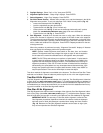
OBSERVING
Observing by Moving the Telescope Manually
If you wish to observe a distant land object, such as a mountain top or a bird, you can observe
by merely pointing the telescope and looking through the eyepiece.
1. Loosen the telescope’s Az lock (19, Fig. 1) and Alt lock (22, Fig. 1).
2. Move your telescope to point at distant street signs, mountains, trees, and other structures.
Use your viewfinder to help site-in on an object.
3. Center the object in the viewfinder’s crosshairs and then in the telescope eyepiece. When
the object is centered in your eyepiece, remember to re-tighten the Az and Alt locks.
4. Practice focusing objects with the focus knob (1, Fig. 1).
5. Once you get a feel for how your telescope moves and focuses, try to view something
more challenging, like a bird or a distant moving train.
You can also observe stars and objects in the night sky using this method, but note that objects
begin to slowly drift across the eyepiece field. This motion is caused by the rotation of the Earth.
As you become familiar with the Autostar handbox operation, you can counteract the drift using
the automatic tracking feature in the Autostar Setup menu (see
TRACKING AN OBJECT AUTO-
MATICALLY, page 14), or by using Autostar's GO TO capabilities (see GO TO SATURN, page 19).
Terrestrial Observing
DS-114AT telescopes are excellent high-resolution, terrestrial (land) telescopes. Viewing ter-
restrial objects requires looking along the Earth's surface through heat waves. These heat
waves often cause degradation of image
quality. Lower power eyepieces, such as
a 25mm eyepiece, magnify these heat
waves less than higher power eyepieces.
Therefore, lower power eyepieces provide a
steadier, higher quality image. If the image
is fuzzy or ill-defined, reduce to a lower
power eyepiece, where the heat waves do
not have such an effect on image quality.
Observing in early morning hours, before
the ground has built up internal heat, pro-
duces better viewing conditions than during
late afternoon hours.
Observing Using Autostar's
Arrow Keys
You may observe land and astronomical
objects using Autostar's Arrow keys to move
the telescope.
1. Tighten the Alt lock (22, Fig. 1) and Az
lock (19, Fig. 1).
2. Verify that Autostar is properly connect-
ed to your telescope.
3. Plug the battery pack into the 12V port.
The Autostar screen is activated and a
copyright message displays briefly, fol-
lowed by a short beep. Then Autostar
takes a few moments to start up the
system.
4. A message displays that warns not to
look at the Sun. At the end of this mes-
sage, press the key prompted by
Autostar to signify that the message
has been read and understood.
13
NEVER
point the
telescope
directly at
or near the Sun at any
time! Observing the
Sun, even for the
smallest fraction of a
second, will result in
instant and irre-
versible eye damage,
as well as physical
damage to the tele-
scope itself.
Too Much Power?
Can you ever have too much power? If the
type of power you’re referring to is eyepiece
magnification, yes, you can! The most com-
mon mistake of the beginning observer is to
“overpower” a telescope by using high magni-
fications which the telescope’s aperture and
atmospheric conditions cannot reasonably
support. Keep in mind that a smaller, but
bright and well-resolved image is far superior
to one that is larger, but dim and poorly
resolved (see below). Powers above 200X
should be employed only under the steadiest
atmospheric conditions.
Autostar can calculate the best eyepiece for
you to use. Try out the “Eyepiece Calc” fea-
ture in the Utilities menu.
Most observers should have three or four
additional eyepieces to achieve the full range
of reasonable magnifications possible with
the DS-114AT telescopes. See “OPTIONAL
ACCESSORIES,” page 31.
Fig. 17a & 17b: Jupiter; example of too
much magnification.
Fig. 16: Autostar's Arrow
keys.


















